Non-Targeted Detection of Adulterants in Almond Powder Using Spectroscopic Techniques Combined with Chemometrics
Abstract
1. Introduction
2. Materials and Methods
2.1. Sample Preparation
2.2. Spectral Collection
3. Data Analysis
3.1. Spectral Preprocessing
3.2. DD-SIMCA and OCPLS
4. Results and Discussion
4.1. Spectral Profile of Almond Samples and Adulterants
4.2. OCPLS-Based Non-Targeted Detection
4.3. DD-SIMCA Model Based on FT-IR and FT-NIR Data
5. Conclusions
Author Contributions
Funding
Conflicts of Interest
References
- Dourado, F.; Barros, A.; Mota, M.; Coimbra, M.A.; Gama, F.M. Anatomy and Cell Wall Polysaccharides of Almond ( Prunus dulcis D. A. Webb) Seeds. J. Agric. Food Chem. 2004, 52, 1364–1370. [Google Scholar] [CrossRef]
- Esteki, M.; Farajmand, B.; Kolahderazi, Y.; Simal-Gandara, J. Chromatographic Fingerprinting with Multivariate Data Analysis for Detection and Quantification of Apricot Kernel in Almond Powder. Food Anal. Methods 2017, 10, 3312–3320. [Google Scholar] [CrossRef]
- Esteki, M.; Vander, H.Y.; Farajmand, B.; Kolahderazi, Y. Qualitative and quantitative analysis of peanut adulteration in almond powder samples using multi-elemental fingerprinting combined with multivariate data analysis methods. Food Control 2017, 82, 31–41. [Google Scholar] [CrossRef]
- Lohumi, S.; Lee, S.; Lee, W.H.; Kim, M.S.; Mo, C.; Bae, H.; Cho, B.K. Detection of starch adulteration in onion powder by FT-NIR and FT-IR spectroscopy. J. Agric. Food Chem. 2014, 62, 9246–9251. [Google Scholar] [CrossRef] [PubMed]
- Lohumi, S.; Joshi, R.; Kandpal, L.M.; Lee, H.; Kim, M.S.; Cho, H.; Mo, C.; Seo, Y.W.; Rahman, A.; Cho, B.K. Quantitative analysis of Sudan dye adulteration in paprika powder using FTIR spectroscopy. Food Addit. Contam. Part A Chem. Anal. Control. Expo. Risk Assess. 2017, 34, 678–686. [Google Scholar] [CrossRef] [PubMed]
- Dhakal, S.; Chao, K.; Qin, J.; Kim, M.; Schmidt, W.; Chan, D. Detection of metanil yellow contamination in turmeric using FT-Raman and FT-IR spectroscopy. Sens. Agric. Food Qual. Saf. VIII 2016, 9864, 98640A. [Google Scholar]
- Cattaneo, T.M.P.; Holroyd, S.E. The use of near infrared spectroscopy for determination of adulteration and contamination in milk and milk powder: Updating knowledge. J. Near Infrared Spectrosc. 2013, 21, 341–349. [Google Scholar] [CrossRef]
- Li, G.-F.; Yin, Q.-B.; Zhang, L.; Kang, M.; Fu, H.-Y.; Cai, C.-B.; Xu, L. Fine classification and untargeted detection of multiple adulterants of Gastrodia elata BI. (GE) by near-infrared spectroscopy coupled with chemometrics. Anal. Methods 2017, 9, 1897–1904. [Google Scholar] [CrossRef]
- Araújo, A.; Marinho, W.; de Araújo Gomes, A. A Fast and Inexpensive Chemometric-Assisted Method to Identify Adulteration in Acai (Euterpe oleracea) Using Digital Images. Food Anal. Methods 2018, 11, 1920–1926. [Google Scholar] [CrossRef]
- Granato, D.; Putnik, P.; Kovačević, D.B.; Santos, J.S.; Calado, V.; Rocha, R.S.; Da Cruz, A.G.; Jarvis, B.; Rodionova, O.Y.; Pomerantsev, A. Trends in Chemometrics: Food Authentication, Microbiology, and Effects of Processing. Compr. Rev. Food Sci. Food Saf. 2018, 17, 663–677. [Google Scholar] [CrossRef]
- Karunathilaka, S.R.; Farris, S.; Mossoba, M.M.; Moore, J.C.; Yakes, B.J. Non-targeted detection of milk powder adulteration using Raman spectroscopy and chemometrics: Melamine case study. Food Addit. Contam. Part A Chem. Anal. Control. Expo. Risk Assess. 2017, 34, 170–182. [Google Scholar]
- Chen, H.; Tan, C.; Lin, Z. Non-destructive identification of native egg by near-infrared spectroscopy and data driven-based class-modeling. Spectrochim. Acta-Part A Mol. Biomol. Spectrosc. 2019, 206, 484–490. [Google Scholar] [CrossRef] [PubMed]
- Fidelis, M.; Santos, J.S.; Coelho, A.L.K.; Rodionova, O.Y.; Pomerantsev, A.; Granato, D. Authentication of juices from antioxidant and chemical perspectives: A feasibility quality control study using chemometrics. Food Control 2017, 73, 796–805. [Google Scholar] [CrossRef]
- Zontov, Y.V.; Balyklova, K.S.; Titova, A.V.; Rodionova, O.Y.; Pomerantsev, A.L. Chemometric aided NIR portable instrument for rapid assessment of medicine quality. J. Pharm. Biomed. Anal. 2016, 131, 87–93. [Google Scholar] [CrossRef]
- Rodionova, O.Y.; Balyklova, K.S.; Titova, A.V.; Pomerantsev, A.L. Application of NIR spectroscopy and chemometrics for revealing of the ‘high quality fakes’ among the medicines. Forensic Chem. 2018, 8, 82–89. [Google Scholar] [CrossRef]
- Rendon, J.L. IR Spectra of Powder Hematite: Effects of Particle Size and Shape. Clay Miner. 1981, 16, 375–382. [Google Scholar] [CrossRef]
- Kandpal, L.M.; Lee, J.; Bae, H.; Kim, M.S.; Baek, I.; Cho, B.K. Near-infrared transmittance spectral imaging for nondestructive measurement of internal disorder in Korean Ginseng. Sensors 2020, 20, 273. [Google Scholar] [CrossRef]
- Rahman, A.; Faqeerzada, M.A.; Cho, B.K. Hyperspectral imaging for predicting the allicin and soluble solid content of garlic with variable selection algorithms and chemometric models. J. Sci. Food Agric. 2018, 98, 4715–4725. [Google Scholar] [CrossRef] [PubMed]
- Rahman, A.; Park, E.; Bae, H.; Cho, B.-K. Hyperspectral imaging technique to evaluate the firmness and the sweetness index of tomatoes. Agric. Sci. Korean J. Agric. Sci. 2018, 45, 823–837. [Google Scholar]
- Kandpal, L.M.; Lee, J.; Bae, J.; Lohumi, S.; Cho, B.K. Development of a Low-Cost Multi-Waveband LED Illumination Imaging Technique for Rapid Evaluation of Fresh Meat Quality. Appl. Sci. 2019, 9, 912. [Google Scholar] [CrossRef]
- Rinnan, Å.; van den Berg, F.; Engelsen, S.B. Review of the most common pre-processing techniques for near-infrared spectra. TrAC-Trends Anal. Chem. 2009, 28, 1201–1222. [Google Scholar] [CrossRef]
- Zontov, Y.V.; Rodionova, O.Y.; Kucheryavskiy, S.V.; Pomerantsev, A.L. DD-SIMCA – A MATLAB GUI tool for data driven SIMCA approach. Chemom. Intell. Lab. Syst. 2017, 167, 23–28. [Google Scholar] [CrossRef]
- Xu, L.; Yan, S.M.; Cai, C.B.; Yu, X.P. One-class partial least squares (OCPLS) classifier. Chemom. Intell. Lab. Syst. 2013, 126, 1–5. [Google Scholar] [CrossRef]
- Sanahuja Beltrán, A.; Moya, M.S.P.; Pérez, S.E.M.; Teruel, N.G.; Carratalá, M.L.M. Classification of four almond cultivars using oil degradation parameters based on FTIR and GC data. JAOCS J. Am. Oil Chem. Soc. 2009, 86, 51–58. [Google Scholar] [CrossRef]
- Yasmin, J.; Lohumi, S.; Ahmed, M.R.; Kandpal, L.M.; Faqeerzada, M.A.; Kim, M.S.; Cho, B.K. Improvement in purity of healthy tomato seeds using an image-based one-class classification method. Sensors 2020, 20, 2690. [Google Scholar] [CrossRef] [PubMed]
- Lohumi, S.; Mo, C.; Kang, J.-S.; Hong, S.-J.; Cho, B.-K. Nondestructive Evaluation for the Viability of Watermelon (Citrullus lanatus) Seeds Using Fourier Transform Near Infrared Spectroscopy. J. Biosyst. Eng. 2013, 38, 312–317. [Google Scholar] [CrossRef]
- Vlachos, N.; Skopelitis, Y.; Psaroudaki, M.; Konstantinidou, V.; Chatzilazarou, A.; Tegou, E. Applications of Fourier transform-infrared spectroscopy to edible oils. Anal. Chim. Acta 2006, 573–574, 459–465. [Google Scholar] [CrossRef]
- Lohumi, S.; Lee, S.; Lee, H.; Cho, B.K. A review of vibrational spectroscopic techniques for the detection of food authenticity and adulteration. Trends Food Sci. Technol. 2015, 46, 85–98. [Google Scholar] [CrossRef]
- Subramanian, A.; Harper, W.J.; Rodriguez-Saona, L.E. Rapid prediction of composition and flavor quality of cheddar cheese using ATR-FTIR spectroscopy. J. Food Sci. 2009, 74, C292–C297. [Google Scholar] [CrossRef]
- Hernández, S.A.; Zacconi, F.C.M. Sweet almond oil: Extraction, characterization and application. Quim. Nova 2009, 32, 1342–1345. [Google Scholar] [CrossRef][Green Version]
- Aenugu, H.P.R.; Sathis Kumar, D.; Srisudharson, N.P.; Ghosh, S.S.; Banji, D. Near infra red spectroscopy—An overview. Int. J. ChemTech Res. 2011, 3, 825–836. [Google Scholar]
- Lohumi, S.; Kandpal, L.M.; Seo, Y.W.; Cho, B.K. Net Analyte Signal-based Quantitative Determination of Fusel Oil in Korean Alcoholic Beverage Using FT-NIR Spectroscopy. J. Biosyst. Eng. 2016, 41, 208–220. [Google Scholar] [CrossRef][Green Version]
- Noah, L.; Robert, P.; Millar, S.; Champ, M. Near-Infrared Spectroscopy As Applied to Starch Analysis of Digestive Contents. J. Agric. Food Chem. 1997, 45, 2593–2597. [Google Scholar] [CrossRef]
- Shenk, J.S.; Jerome, J.; Workman, J.; Westerhaus, M.O. Application of NIR Spectroscopy to Agricultural Products. In Handbook of Near-Infrared Analysis, 3rd ed.; CRC Press: Boca Ratona, FL, USA, 2007. [Google Scholar]
- Yasmin, J.; Ahmed, M.R.; Lohumi, S.; Wakholi, C.; Kim, M.S.; Cho, B.K. Classification method for viability screening of naturally aged watermelon seeds using FT-NIR spectroscopy. Sensors 2019, 19, 1190. [Google Scholar] [CrossRef]
- Kusumaningrum, D.; Lee, H.; Lohumi, S.; Mo, C.; Kim, M.S.; Cho, B.K. Non-destructive technique for determining the viability of soybean (Glycine max) seeds using FT-NIR spectroscopy. J. Sci. Food Agric. 2018, 98, 1734–1742. [Google Scholar] [CrossRef]
- Guille, M.D.; Cabo, N. Infrared Spectroscop y in the Stud y of Edible Oils and Fats. J. Sci. Food Agric. 1997, 75, 1–11. [Google Scholar] [CrossRef]
- Contal, L.; Leon, V.; Downey, G. Detection and quantification of apple adulteration in strawberry and raspberry purees using visible and near infrared spectroscopy. Near Inferared Spectrosc. 2002, 10, 289–299. [Google Scholar] [CrossRef]
- Laasonen, M.; Harmia-Pulkkinen, T.; Simard, C.L.; Michiels, E.; Räsänen, M.; Vuorela, H. Fast Identification of Echinacea purpurea Dried Roots Using Near-Infrared Spectroscopy. Anal. Chem. 2002, 74, 2493–2499. [Google Scholar] [CrossRef]
- Osborne, B. Near-Infrared Spectroscopy in Food Analysis; Wiley: Hoboken, NJ, USA; Chichester, UK, 2000; ISBN 0582494893. [Google Scholar]
- Arbuckle, G.A.; Buecheler, N.M.; Hall, J.W.; Valentine, K.G.; Lefrant, S.; Mevellec, J.Y.; Mulazzi, E. Spectroscopic properties of polyacetylenes synthesized via three modifications of Ziegler-Natta catalytic system. Synth. Met. 1996, 79, 183–188. [Google Scholar] [CrossRef]
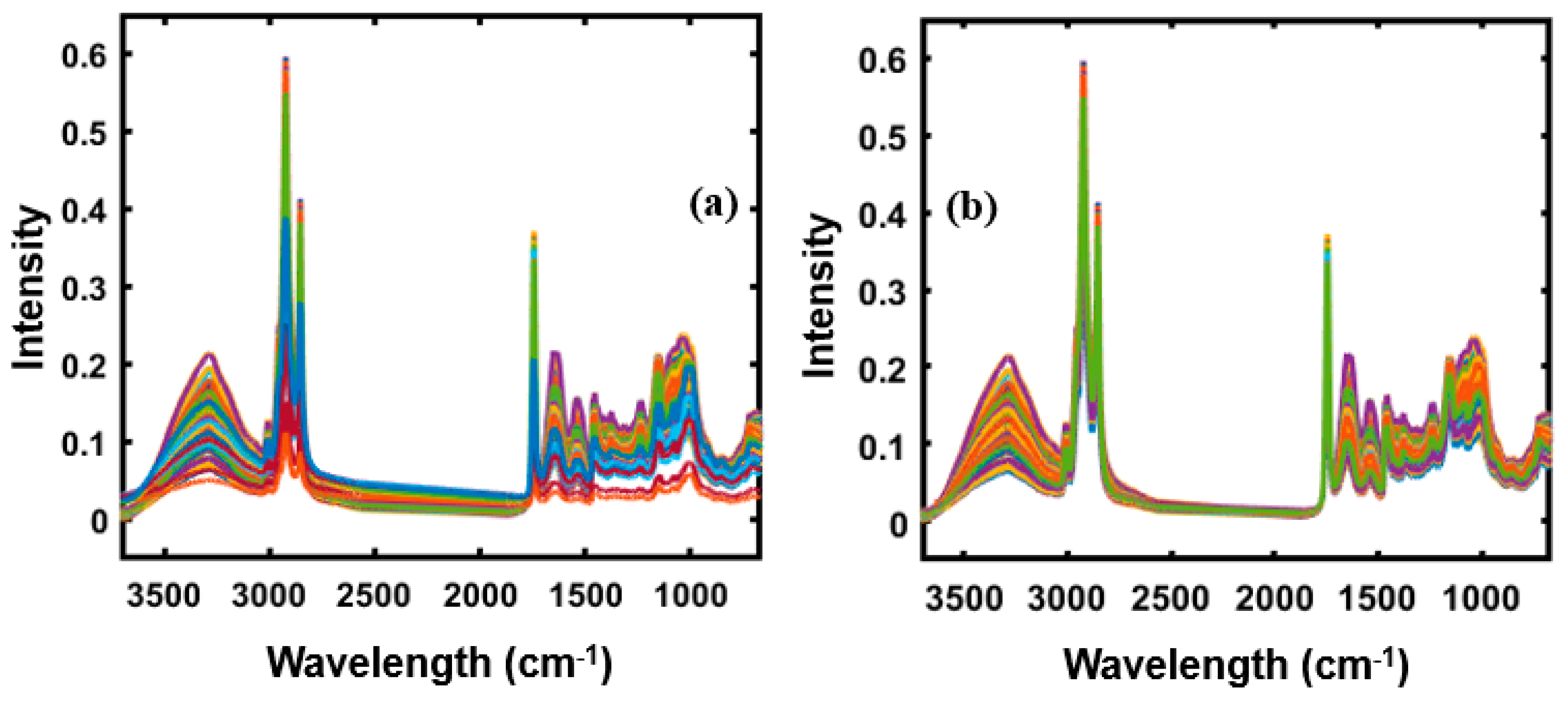
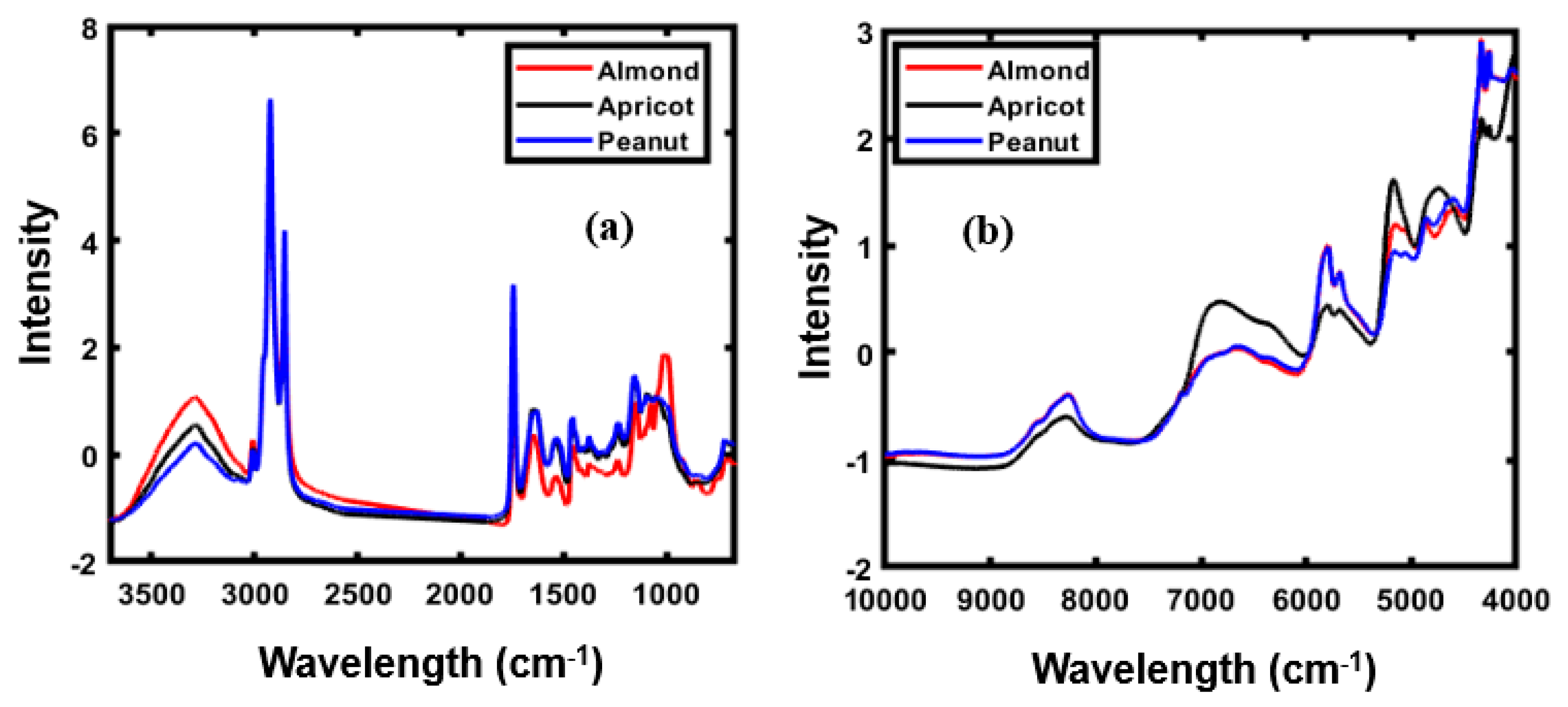
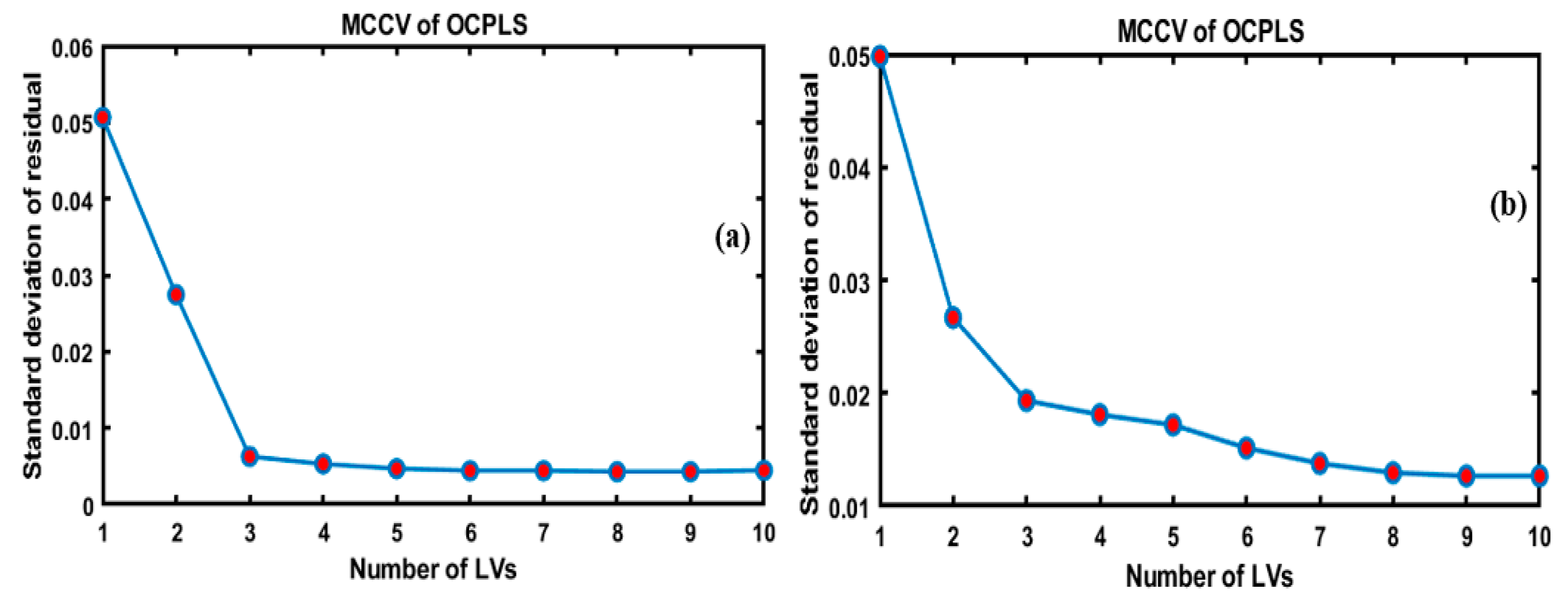
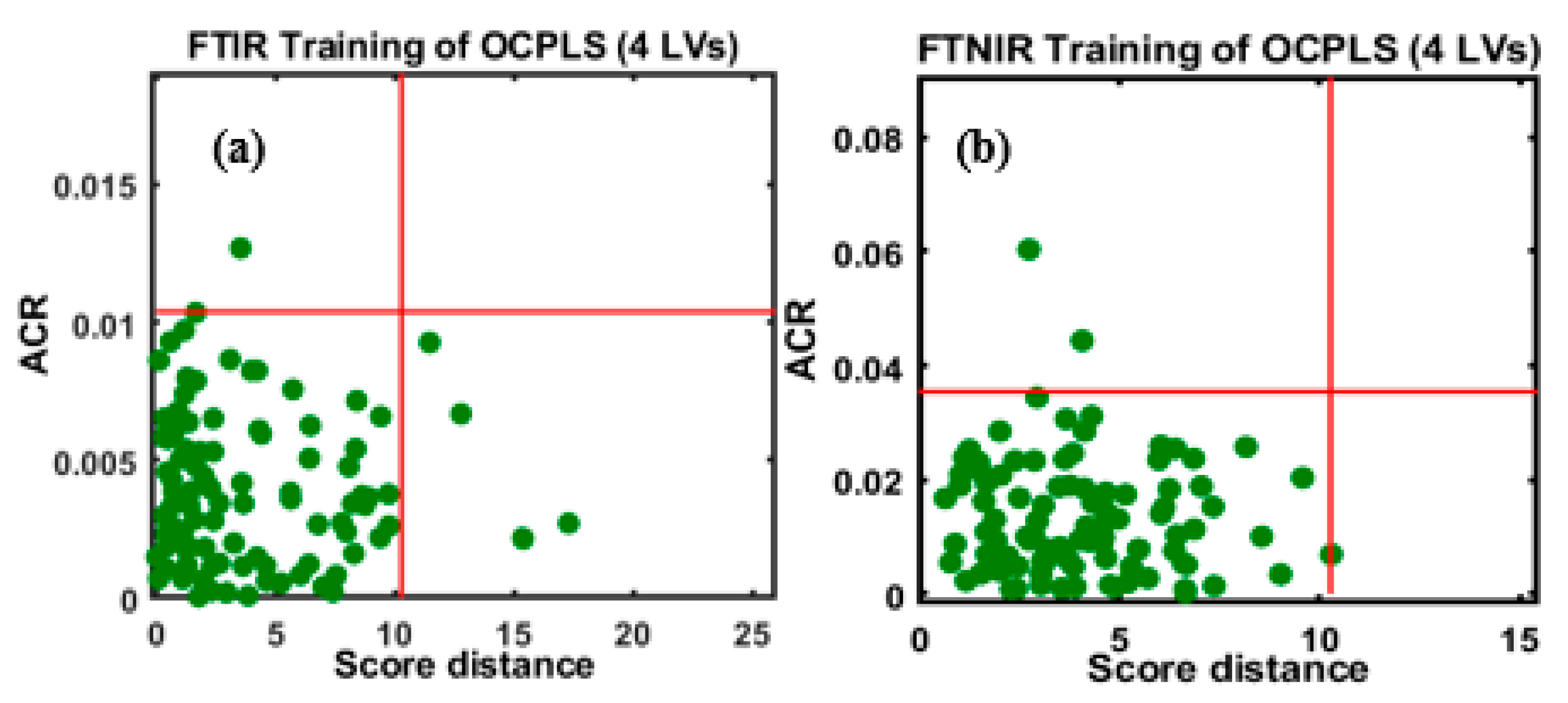

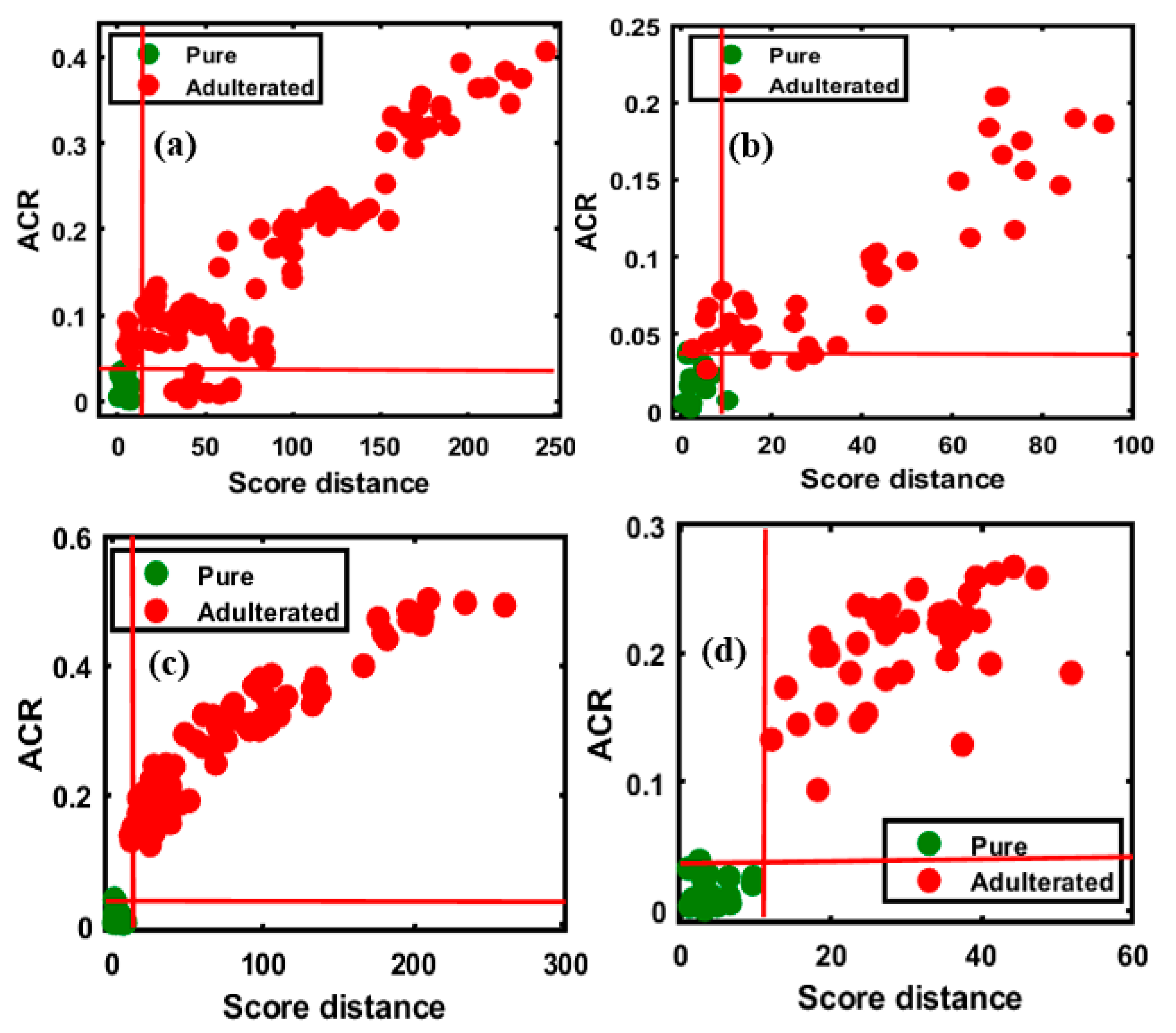
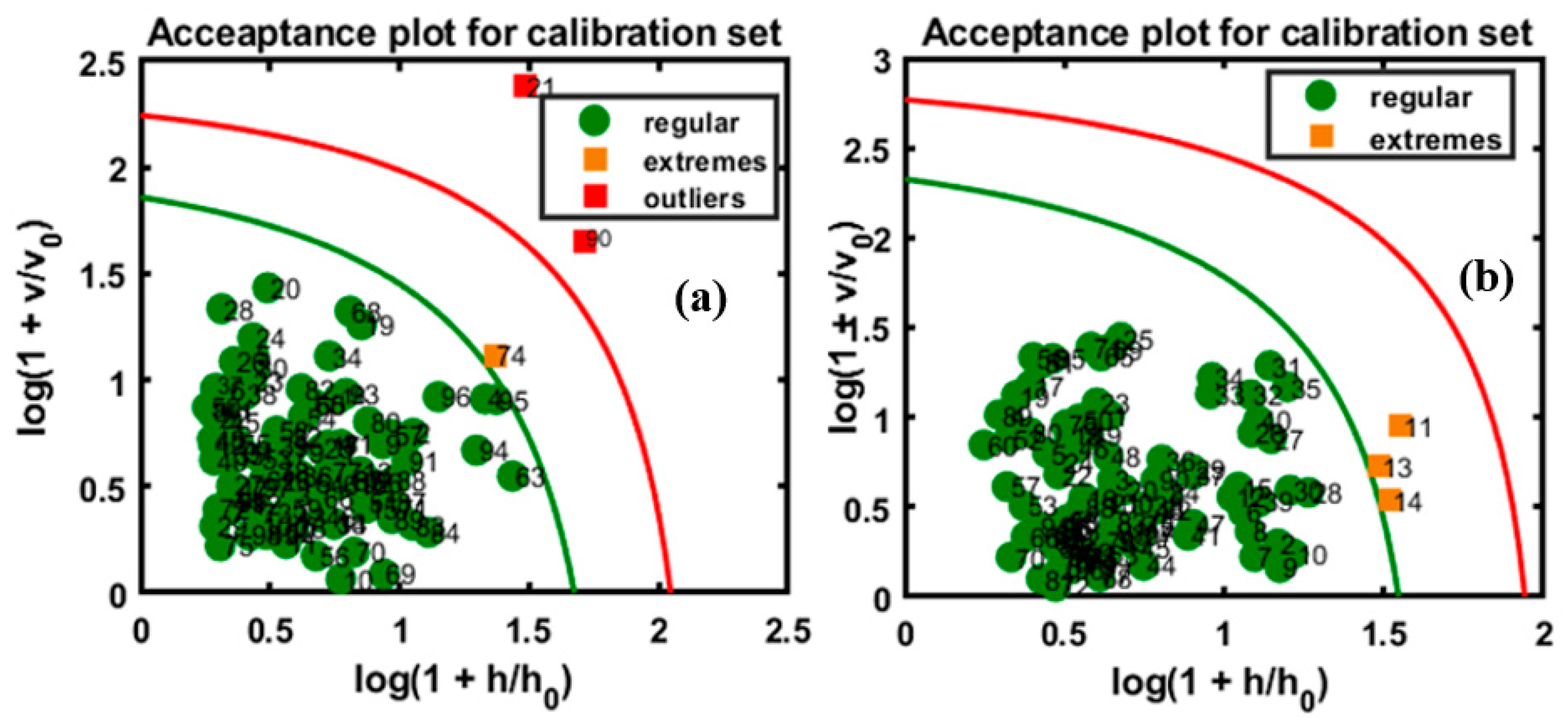

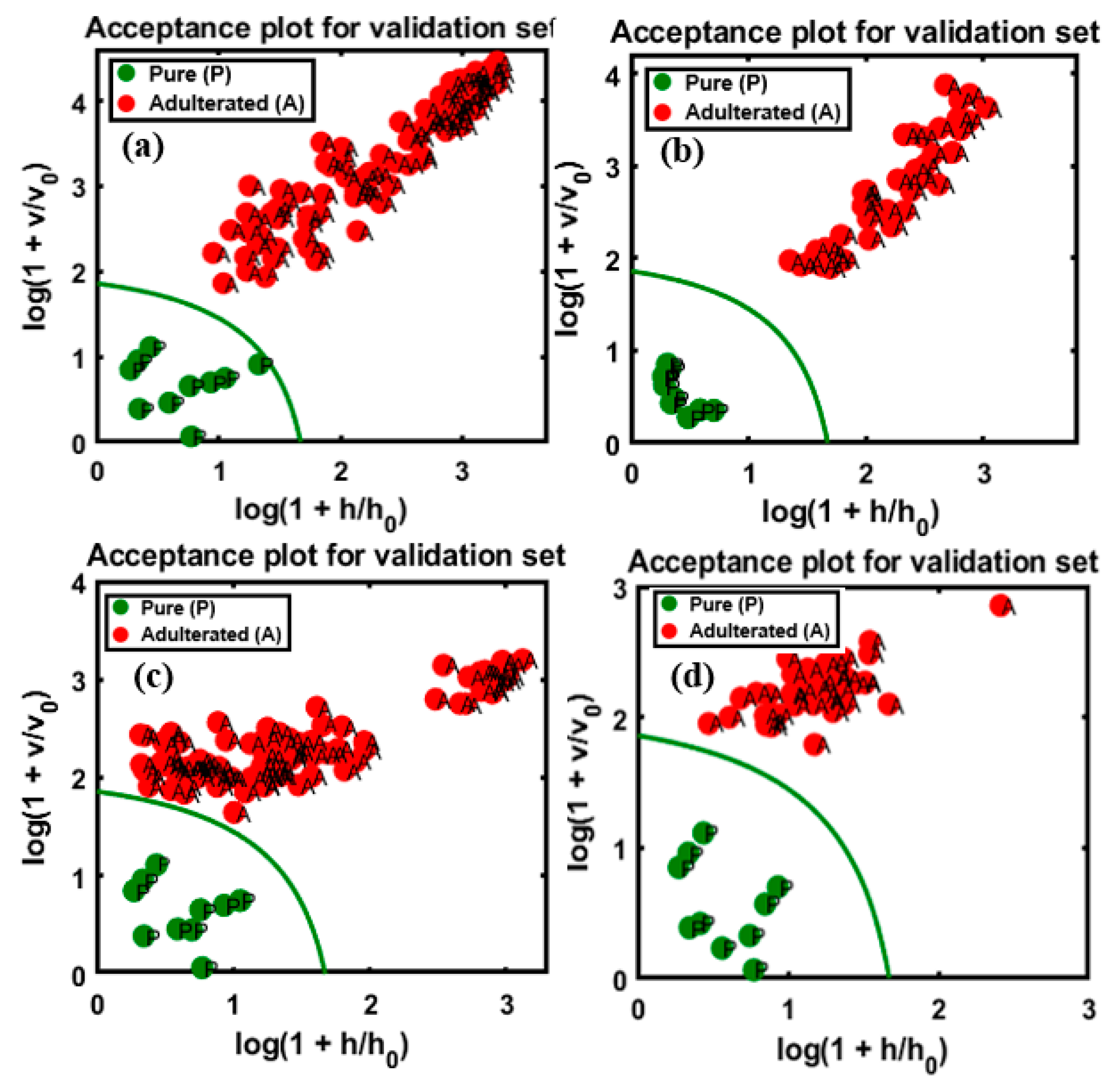

| DD-SIMCA and OCPLS | Number of Samples | Maximum | Minimum | |
|---|---|---|---|---|
| FT-IR | Calibration | 100 | 100 | 0 |
| Validation 1 | 110 | 50 | 0 | |
| Validation 2 | 50 | 30 | 0 | |
| FT-NIR | Calibration | 100 | 100 | 0 |
| Validation 1 | 110 | 50 | 0 | |
| Validation 2 | 50 | 30 | 0 | |
| Adulterants | Sensitivity (%) | Number of Correctly Classified Samples/Total Number of Samples | Specificity (%) | Number of Correctly Classified Samples/Total Number of Samples | Accuracy (%) | |
|---|---|---|---|---|---|---|
| DD-SIMCA Result | Val-1st variety (almond + apricot) | 100 | 100/100 | 80 | 8/10 | 98.18 |
| Val-2nd variety (almond + apricot) | 100 | 40/40 | 100 | 10/10 | 100 | |
| Val-1st variety (almond + peanut) | 98 | 98/100 | 90 | 9/10 | 97.27 | |
| Val-12nd variety (almond + peanut) | 100 | 40/40 | 100 | 10/10 | 100 | |
| OCPLS Result | Val-1st variety (almond + apricot) | 100 | 100/100 | 100 | 10/10 | 100 |
| Val-2nd variety (almond + apricot) | 100 | 100/100 | 100 | 10/10 | 100 | |
| Val-1st variety (almond + peanut) | 100 | 100/100 | 100 | 10/10 | 100 | |
| Val-2nd variety (almond + peanut) | 100 | 100/100 | 100 | 10/10 | 100 | |
| Adulterants | Sensitivity (%) | Number of Correctly Classified Samples/Total Number of Samples | Specificity (%) | Number of Correctly Classified Samples/Total Number of Samples | Accuracy (%) | |
|---|---|---|---|---|---|---|
| DD-SIMCA Result | Val-1st variety (almond + apricot) | 100 | 100/100 | 93 | 14/15 | 99.13 |
| Val-2nd variety (almond + apricot) | 97 | 39/40 | 93 | 1/15 | 90.90 | |
| Val-1st variety (almond + peanut) | 100 | 100/100 | 93 | 14/15 | 99.13 | |
| Val-2nd variety (almond + peanut) | 100 | 40/40 | 93 | 14/15 | 98.18 | |
| OCPLS Result | Val-1st variety (almond + apricot) | 100 | 100/100 | 100 | 15/15 | 100 |
| Val-2nd variety (almond + apricot) | 100 | 40/40 | 100 | 15/15 | 100 | |
| Val-1st variety (almond + peanut) | 91 | 91/100 | 93 | 14/15 | 91.30 | |
| Val-2nd variety (almond + peanut) | 92.5 | 37/40 | 100 | 15/15 | 94.54 | |
© 2020 by the authors. Licensee MDPI, Basel, Switzerland. This article is an open access article distributed under the terms and conditions of the Creative Commons Attribution (CC BY) license (http://creativecommons.org/licenses/by/4.0/).
Share and Cite
Faqeerzada, M.A.; Lohumi, S.; Joshi, R.; Kim, M.S.; Baek, I.; Cho, B.-K. Non-Targeted Detection of Adulterants in Almond Powder Using Spectroscopic Techniques Combined with Chemometrics. Foods 2020, 9, 876. https://doi.org/10.3390/foods9070876
Faqeerzada MA, Lohumi S, Joshi R, Kim MS, Baek I, Cho B-K. Non-Targeted Detection of Adulterants in Almond Powder Using Spectroscopic Techniques Combined with Chemometrics. Foods. 2020; 9(7):876. https://doi.org/10.3390/foods9070876
Chicago/Turabian StyleFaqeerzada, Mohammad Akbar, Santosh Lohumi, Rahul Joshi, Moon S. Kim, Insuck Baek, and Byoung-Kwan Cho. 2020. "Non-Targeted Detection of Adulterants in Almond Powder Using Spectroscopic Techniques Combined with Chemometrics" Foods 9, no. 7: 876. https://doi.org/10.3390/foods9070876
APA StyleFaqeerzada, M. A., Lohumi, S., Joshi, R., Kim, M. S., Baek, I., & Cho, B.-K. (2020). Non-Targeted Detection of Adulterants in Almond Powder Using Spectroscopic Techniques Combined with Chemometrics. Foods, 9(7), 876. https://doi.org/10.3390/foods9070876






